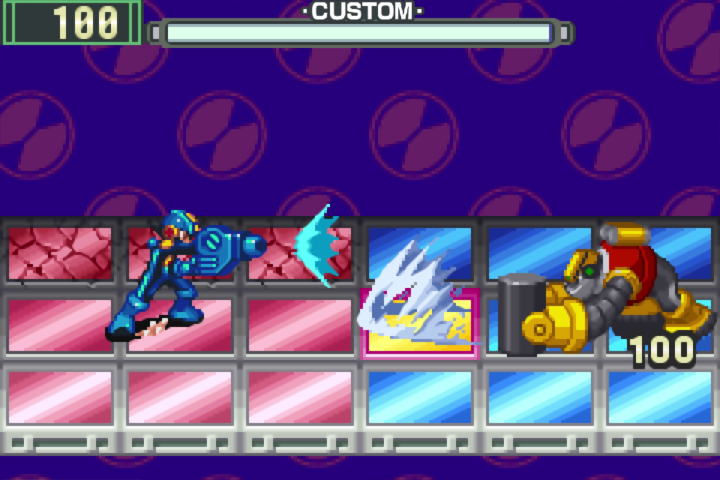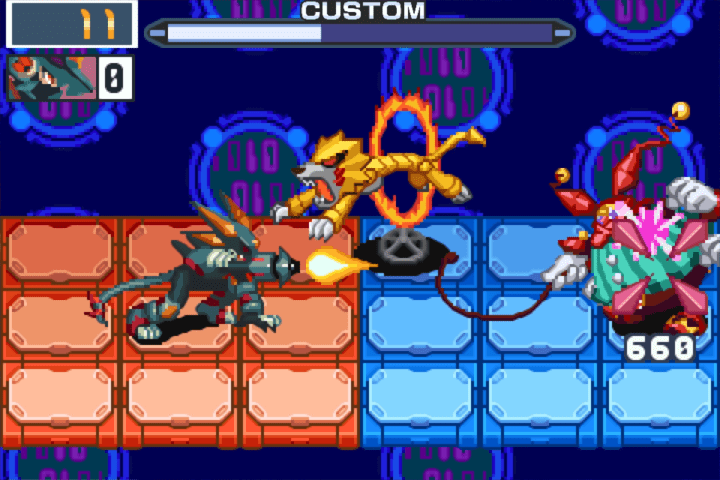In an industry where video game franchises continue for decades, it’s always surprising when a popular series ends. That was the case with Mega Man Battle Network, Capcom’s beloved tactical RPG series that still has a fierce cult following today. The Mega Man spinoff moved like a whirlwind in the early 2000s, debuting on the Game Boy Advance in 2001 and releasing six mainline titles through 2005. Its momentum stopped dead after that, going from an annualized series to a defunct one in the blink of an eye.
Now 18 years after the release of its final game, Mega Man Battle Network Legacy Collection is giving the series its nostalgic moment in the sun. The compilation includes all six mainline games, some of which have two different versions like Pokémon. That means fans are getting 10 RPGS for the price of one, making it the most “bang for your buck” game release of the year so far. Regardless of whether or not every single one is worth playing, it’s an easy recommendation.
What makes Mega Man Battle Network Legacy Collection particularly useful, though, is its role as a historical document. By putting those busy few years of Game Boy Advance glory back to back, it’s easy to see both why fans still love it and where Capcom went wrong in aggressively trying to capitalize on it. It’s as much a postmortem for Mega Man Battle Network as it is a celebration of it.
Jack in
The Mega Man Battle Network series is a creative spinoff of the classic platforming series that still feels fresh today. It takes place in a futuristic society where technology controls everything from dog houses to classrooms. Of course, that makes everything an easy target for cybercriminals and terrorist organizations like the World Three (WWW). Players take control of Lan, a young kid who’s able to jack into any device connected to the web and clear out viruses with the help of Mega Man.

As far as ports go, there’s not much to complain about in Mega Man Battle Network Legacy Collection. All 10 mainline games are faithfully preserved here and Capcom has even gone as far as to include special bonus cards that were only available in Japan through the Game Boy Advance e-Reader. There’s a rather hideous filter that smooths out all of the crunchy GBA pixels, but fortunately, that can be toggled off. The closest thing I have to a critique is that dialogue fonts have been replaced with a much smoother one that’s out of place with the visuals and can’t be changed.
The games themselves hold up extraordinarily well, something that’s been true of a lot of recent GBA re-releases. The core combat feels as fresh as a modern indie game in 2023, smashing genres together in a way that still feels inventive. It’s a deck-builder where players put together a set of chips that can be used in real-time tactical battles that unfold on a grid. Each time Mega Man’s energy bar fills up, players can pause the battle and select a handful of chips, though they can mostly only equip ones that have the same letter code. The idea is to create a synergistic set of chips that create more opportunities for combos each time the bar refills and a new hand is dealt.
I was quickly hooked on that system the moment I began testing out the first game. It’s an engaging combat loop that constantly rewards smart builds. Though its glut of random encounters can be tiring, each one gave me a chance to tweak my chips en route to a larger boss fight and see how fast I could wipe out a screen full of enemies. Any time a battle ended in mere seconds, I felt like an engineering genius.

There’s plenty that hasn’t aged as gracefully, from obtuse objectives to repetitive world design, but all of that’s expected from a series that’s two decades old. The collection at least tries to help mitigate some of that with an optional mode that buffs Mega Man’s damage output, allowing him to bypass a lot of random battles quickly. It’s not as useful as a fast-forward tool that we’ve seen in recent RPG remasters like Chrono Cross: The Radical Dreamer Edition, but it’s a good way to get new players through some surprisingly fun stories about techno-terrorists. The only feature I wish it had was something to counteract its reliance on manual saves, a system that set me back for half-hours at a time after forgetting to save for long stretches and dying on a random fight.
Nitpicks aside, I’m having plenty of fun diving into a solid collection of kid-friendly RPGs that call back to a golden era of handheld innovation. I’m at my most engaged, though, when I’m piecing together why the series came to such an abrupt end.
Log out
What’s immediately noticeable when jumping between games is how nearly identical they feel. When I go from Mega Man Battle Network to its sixth game, it feels like I’m diving into a full sequel as Lan travels to a new school. Everything in between those two stories feels more like an incremental update. When Mega Man Battle Network 2 begins, I’m immediately dropped into the exact same classroom from the first game and given the same basic tutorial. The same thing happens when I flip over to the third game as if I’m playing one continuous 120-hour RPG that stops to reset players’ progress every 20 hours.
Any changes between games are subtle. Later iterations of the battle system would allow Mega Man to counter enemy attacks with the proper timing or change how to add more chips during a turn, but the core idea never really changes. I’m always walking around familiar overworlds with Lan, jacking into objects to send Mega Man into digital spaces that gradually improve in design each game, and doing a whole lot of tactical battles. Even some of the larger changes to 4 and 5 don’t feel as drastic now as they did at the time.

I don’t say that to disparage the series; the formula is fun each time and the stories are different enough to motivate me through them. It does, however, make me understand why the series needed to end at that moment. It’s very apparent that these games were churned out on an annual schedule with Capcom recycling assets, UI, and systems over and over. No game feels like a true evolution so much as another chapter. Imagine if mainline Pokémon installments were only spaced one year apart instead of four and you can start to imagine how diminishing the excitement would be each time.
You can see that in action when looking back through reviews of the series at the time. Critics were high on the first two games, but the consensus began to drop with each entry. You get a sense of fatigue reading those old reviews as it becomes clear that writers simply had nothing new to say with each passing year. Playing through each game now, I can feel how Capcom was perhaps over-eager to capitalize on a lightning-in-a-bottle idea and create its own handheld sensation that needlessly mimicked Pokémon’s dual-release structure (series like Bomberman would try the same strategy on the GBA). The series’ fate might have been different if those six games were spread across the GBA, DS, and 3DS, but rapid-fire annualization weakened its power each time and that’s felt when playing them all back to back here. If you don’t care much for the story, you can more or less just play Mega Man Battle Network 3 here and leave fulfilled.
Even if that’s how you choose to engage with it, Mega Man Battle Network Legacy Collection is something of a must-own historical document for fans of the series and portable gaming buffs alike. It’s an easy way to perform an autopsy of a once-great franchise — one that makes me feel at peace with Capcom’s decision to put a pin in it when it did. Why keep churning out games when there’s nothing new to say? The six still great games featured here are more than enough to keep the series’ legacy alive.
Mega Man Battle Network Legacy Collection launches on April 14 for Nintendo Switch, PS4, and PC.
Editors’ Recommendations
Stay connected with us on social media platform for instant update click here to join our Twitter, & Facebook
We are now on Telegram. Click here to join our channel (@TechiUpdate) and stay updated with the latest Technology headlines.
For all the latest Gaming News Click Here
